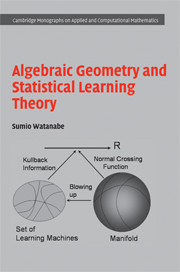1 - Introduction
Published online by Cambridge University Press: 10 January 2011
Summary
In this book, we study a system which perceives the real world. Such a system has to estimate an information source by observation. If the information source is a probability distribution, then the estimation process is called statistical learning, and the system is said to be a statistical model or a learning machine.
A lot of statistical models have hierarchical layers, hidden variables, a collection of modules, or grammatical structures. Such models are nonidentifiable and contain singularities in their parameter spaces. In fact, the map from a parameter to a statistical model is not one-to-one, and the Fisher information matrix is not positive definite. Such statistical models are called singular. It has been difficult to examine the learning process of singular models, because there has been no mathematical theory for such models.
In this book, we establish a mathematical foundation which enables us to understand the learning process of singular models. This chapter gives an overview of the book before a rigorous mathematical foundation is developed.
Basic concepts in statistical learning
To describe what statistical learning is, we need some basic concepts in probability theory. For the reader who is unfamiliar with probability theory, Section 1.6 summarizes the key results.
Random samples
Let N be a natural number and ℝN be the N-dimensional real Euclidean space. We study a case when information data are represented by vectors in ℝN.
Information
- Type
- Chapter
- Information
- Algebraic Geometry and Statistical Learning Theory , pp. 1 - 47Publisher: Cambridge University PressPrint publication year: 2009
